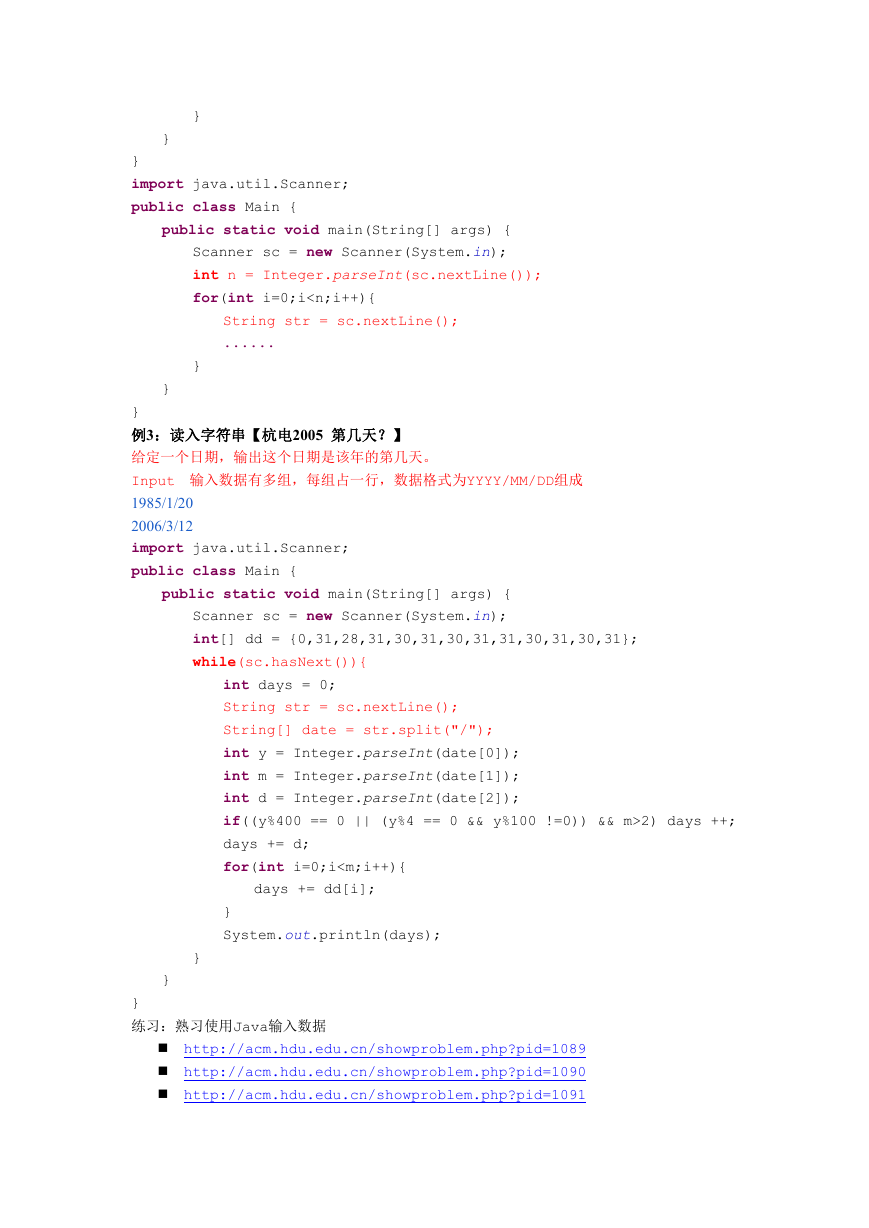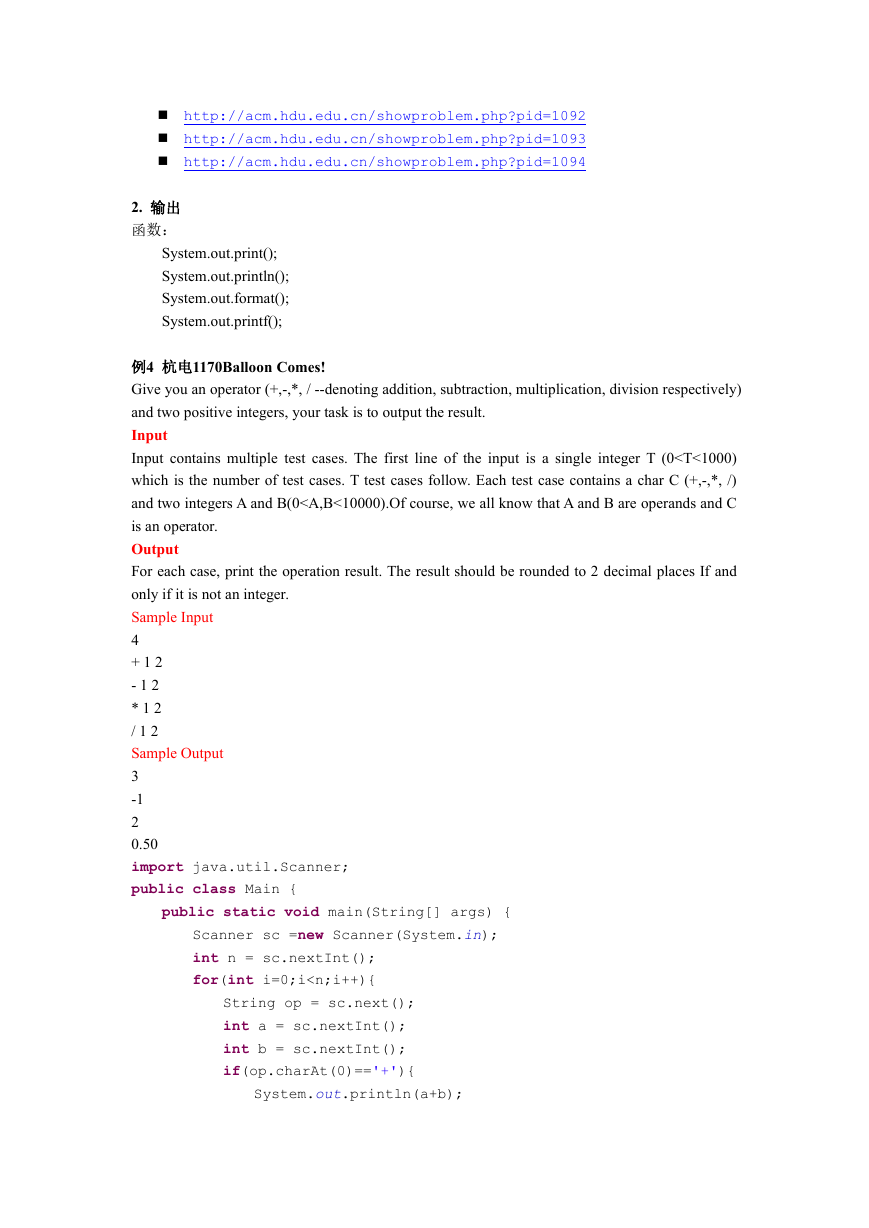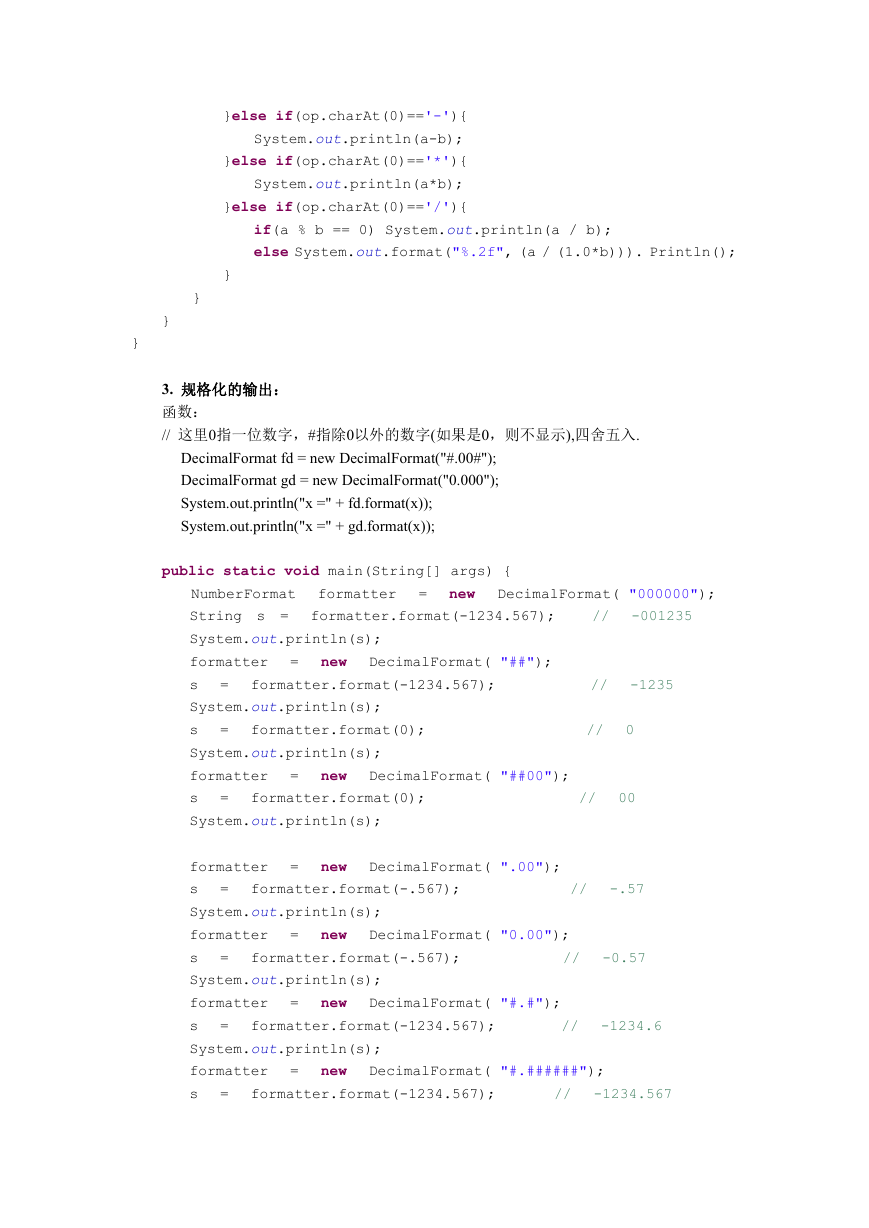http://acm.hdu.edu.cn/showproblem.php?pid=1092
http://acm.hdu.edu.cn/showproblem.php?pid=1093
http://acm.hdu.edu.cn/showproblem.php?pid=1094
2. 输出
函数:
System.out.print();
System.out.println();
System.out.format();
System.out.printf();
例4 杭电1170Balloon Comes!
Give you an operator (+,-,*, / --denoting addition, subtraction, multiplication, division respectively)
and two positive integers, your task is to output the result.
Input
Input contains multiple test cases. The first line of the input is a single integer T (0
}else if(op.charAt(0)=='-'){
System.out.println(a-b);
}else if(op.charAt(0)=='*'){
System.out.println(a*b);
}else if(op.charAt(0)=='/'){
if(a % b == 0) System.out.println(a / b);
else System.out.format("%.2f", (a / (1.0*b))). Println();
}
}
}
}
3. 规格化的输出:
函数:
// 这里0指一位数字,#指除0以外的数字(如果是0,则不显示),四舍五入.
DecimalFormat fd = new DecimalFormat("#.00#");
DecimalFormat gd = new DecimalFormat("0.000");
System.out.println("x =" + fd.format(x));
System.out.println("x =" + gd.format(x));
public static void main(String[] args) {
formatter
formatter.format(-1234.567);
=
new
DecimalFormat( "000000");
//
-001235
=
=
new
NumberFormat
String s =
System.out.println(s);
formatter
s
System.out.println(s);
s
System.out.println(s);
formatter
s
System.out.println(s);
new
=
=
=
new
=
=
=
=
new
formatter
s
System.out.println(s);
formatter
s
System.out.println(s);
formatter
s
System.out.println(s);
formatter
s
new
new
=
=
=
=
DecimalFormat( "##");
formatter.format(-1234.567);
formatter.format(0);
DecimalFormat( "##00");
formatter.format(0);
//
-1235
//
0
//
00
//
-.57
DecimalFormat( ".00");
formatter.format(-.567);
formatter.format(-.567);
DecimalFormat( "0.00");
//
-0.57
DecimalFormat( "#.#");
formatter.format(-1234.567);
//
-1234.6
DecimalFormat( "#.######");
formatter.format(-1234.567);
//
-1234.567
�
=
=
new
System.out.println(s);
formatter
s
System.out.println(s);
formatter
s
System.out.println(s);
new
=
=
new
=
=
formatter
s
System.out.println(s);
s
System.out.println(s);
=
DecimalFormat( ".######");
formatter.format(-1234.567);
//
-1234.567
DecimalFormat( "#.000000");
formatter.format(-1234.567);
//
-1234.567000
DecimalFormat( "#,###,###");
formatter.format(-1234.567);
//
-1,235
formatter.format(-1234567.890); //
-1,234,568
//
The
;
symbol
used
to
specify
an
alternate
pattern
for
negative
is
values
new
=
formatter
s
System.out.println(s);
=
DecimalFormat( "#;(#) ");
formatter.format(-1234.567);
//
(1235)
is
used
to
quote
literal
symbols
DecimalFormat( " '# '# ");
formatter.format(-1234.567);
//
-#1235
DecimalFormat( " 'abc '# ");
formatter.format(-1234.567);
// - abc 1235
=
=
'
The
symbol
new
//
formatter
s
System.out.println(s);
formatter
s
System.out.println(s);
new
=
=
new
=
formatter
s
System.out.println(s);
=
formatter.format(-12.5678987);
DecimalFormat( "#.##%");
}
http://acm.hdu.edu.cn/showproblem.php?pid=1012
4. 字符串处理 String
String 类用来存储字符串,可以用charAt方法来取出其中某一字节,计数从0开始:
String a = "Hello"; // a.charAt(1) = 'e'
用substring方法可得到子串,如上例
System.out.println(a.substring(0, 4)) // output "Hell"
注意第2个参数位置上的字符不包括进来。这样做使得 s.substring(a, b) 总是有 b-a个字符。
字符串连接可以直接用 + 号,如
String a = "Hello";
String b = "world";
System.out.println(a + ", " + b + "!"); // output "Hello, world!"
�
如想直接将字符串中的某字节改变,可以使用另外的StringBuffer类。
5. 高精度
BigInteger和BigDecimal可以说是acmer选择java的首要原因。
函数:add, subtract, divide, mod, compareTo等,其中加减乘除模都要求是
BigInteger(BigDecimal)和BigInteger(BigDecimal)之间的运算,所以需要把int(double)类型转换
为BigInteger(BigDecimal),用函数BigInteger.valueOf().
例程:
import java.io.BufferedInputStream;
import java.math.BigInteger;
import java.util.Scanner;
public class Main {
public static void main(String[] args)
{
Scanner cin = new Scanner (new BufferedInputStream(System.in));
int a = 123, b = 456, c = 7890;
BigInteger x, y, z, ans;
x = BigInteger.valueOf(a);
y = BigInteger.valueOf(b);
z = BigInteger.valueOf(c);
ans = x.add(y); System.out.println(ans);
ans = z.divide(y); System.out.println(ans);
ans = x.mod(z); System.out.println(ans);
if (ans.compareTo(x) == 0) System.out.println("1");
}
}
http://acm.hdu.edu.cn/showproblem.php?pid=1018
http://acm.hdu.edu.cn/showproblem.php?pid=1013
http://acm.hdu.edu.cn/showproblem.php?pid=1002
6. 进制转换
java很强大的一个功能。
函数:
String st = Integer.toString(num, base); // 把num当做10进制的数转成base进制的st(base <= 35).
int num = Integer.parseInt(st, base); // 把st当做base进制,转成10进制的int(parseInt有两个参数,
第一个为要转的字符串,第二个为说明是什么进制).
BigInter m = new BigInteger(st, base); // st是字符串,base是st的进制.
7. 数组排序
函数:Arrays.sort();
�
public class Main {
Scanner cin = new Scanner (new BufferedInputStream(System.in));
int n = cin.nextInt();
int a[] = new int [n];
for (int i = 0; i < n; i++) a[i] = cin.nextInt();
Arrays.sort(a);
for (int i = 0; i < n; i++) System.out.print(a[i] + " ");
public static void main(String[] args)
{
}
}
�
















 2023年江西萍乡中考道德与法治真题及答案.doc
2023年江西萍乡中考道德与法治真题及答案.doc 2012年重庆南川中考生物真题及答案.doc
2012年重庆南川中考生物真题及答案.doc 2013年江西师范大学地理学综合及文艺理论基础考研真题.doc
2013年江西师范大学地理学综合及文艺理论基础考研真题.doc 2020年四川甘孜小升初语文真题及答案I卷.doc
2020年四川甘孜小升初语文真题及答案I卷.doc 2020年注册岩土工程师专业基础考试真题及答案.doc
2020年注册岩土工程师专业基础考试真题及答案.doc 2023-2024学年福建省厦门市九年级上学期数学月考试题及答案.doc
2023-2024学年福建省厦门市九年级上学期数学月考试题及答案.doc 2021-2022学年辽宁省沈阳市大东区九年级上学期语文期末试题及答案.doc
2021-2022学年辽宁省沈阳市大东区九年级上学期语文期末试题及答案.doc 2022-2023学年北京东城区初三第一学期物理期末试卷及答案.doc
2022-2023学年北京东城区初三第一学期物理期末试卷及答案.doc 2018上半年江西教师资格初中地理学科知识与教学能力真题及答案.doc
2018上半年江西教师资格初中地理学科知识与教学能力真题及答案.doc 2012年河北国家公务员申论考试真题及答案-省级.doc
2012年河北国家公务员申论考试真题及答案-省级.doc 2020-2021学年江苏省扬州市江都区邵樊片九年级上学期数学第一次质量检测试题及答案.doc
2020-2021学年江苏省扬州市江都区邵樊片九年级上学期数学第一次质量检测试题及答案.doc 2022下半年黑龙江教师资格证中学综合素质真题及答案.doc
2022下半年黑龙江教师资格证中学综合素质真题及答案.doc